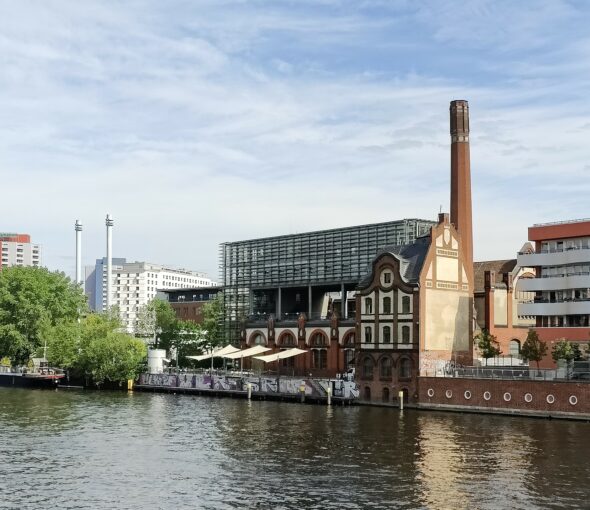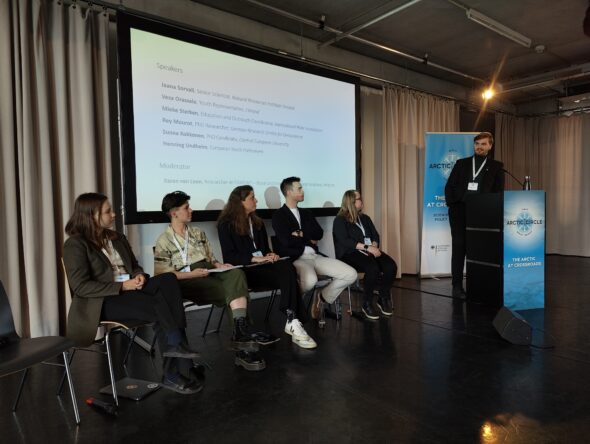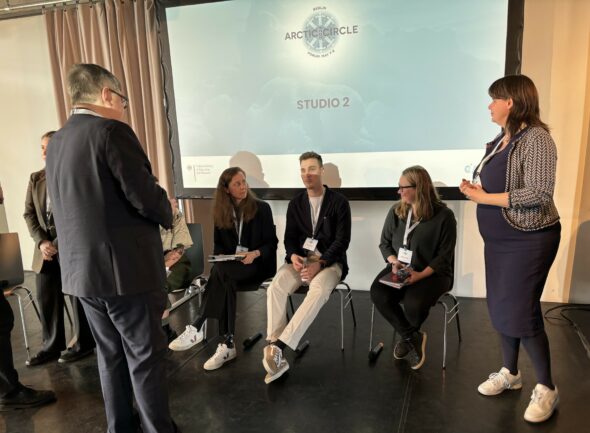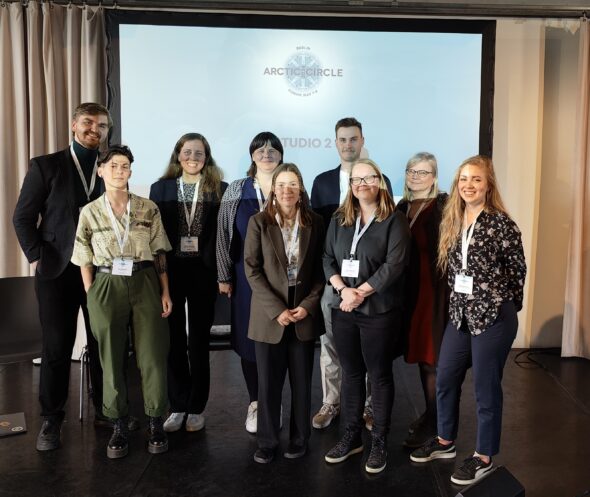What do young people living in or working with the Arctic think and want? What is the young generation’s role in shaping the Arctic region?
The ACAF project team joined the Artic Circle Berlin Forum 2024, organised in Berlin May 7-8. The forum brought together over 300 scholars, politicians and professionals who all share a passion for the Arctic region. In the spirit of our project, we aimed to bring the perspective of young people to the discussion. In collaboration with the ArcticHubs project, coordinated by the Natural Resources Institute Finland, the Belgian EGMONT Royal Institute for International Relations, and Association for Polar Early Career Scientists (APECS) Germany, the ACAF project organised a panel discussion with young participants who themselves live in or work with the Arctic region. Although the importance of youth was emphasised in a number of speeches at the forum, the presence of young people as presenters was limited. Our panel discussion was an opportunity for the conference participants to hear from the young people themselves as well as professionals working with the themes of childhood, youth and the Arctic region.

Why should we care about the Arctic even outside of the Arctic?
While the centrality of the Arctic region seemed to be clear to the forum participants in Berlin, in wider society its importance isn’t always recognised – especially in regions further away from the polar circle. The Arctic region, however, is especially vulnerable to climate change and it is heating up three times faster than the global average. Climate change is already changing the lives of the people living above the circumpolar north. Mieke Sterken, education and outreach coordinator at the International Polar Foundation, working in Belgium with educating children, young people and school professionals about the Arctic highlighted how things that happen in the Arctic do not stay in the Arctic – similarly, what happens in the world beyond the Arctic region has an effect on the Arctic. It is crucial to raise Arctic awareness in places like Belgium to foster a greater sense of global connectedness in the face of global challenges like the climate change. The turbulence caused by the changing climate conditions in the Arctic is impacting the futures young people in the Arctic imagine for themselves. However, as brought up by Mieke, climate change is felt also in Belgium. Hence, what happens in the Arctic has an effect on Belgium – and vice versa.
“It really is a different world” – special characteristics of the Arctic
While we should not fall into the trap of Arctic exceptionalism and view the Arctic as inherently separate from the rest of the world, the special characteristics of the Arctic must be kept in mind while discussing it. In her contribution, Sunna Kokkonen, a PhD researcher at the Central European University reflected on her own position as being from the very north of Finland and now living in Central Europe. Sunna described how moving to first southern Finland and then abroad felt comparable: moving abroad didn’t feel any more foreign than moving to southern Finland. The Arctic really is a different world, even within Finland.
Similarly, Vesa Orassalo, a student living in Rovaniemi, Finland, and born in the Arctic region of Finland, emphasised how different growing up in the remote Arctic feels extremely different to living in the urban Arctic. He described how the lack of nature had shocked him: in Rovaniemi, one cannot “feel nature” or the wilderness that for him defined much of his activities and which seasonal changes structure the year. In the beginning of his contribution Vesa offered a disclaimed: I can tell you, but you won’t understand it without experiencing it. The Arctic wilderness and life there is unique in experience: it’s the sensory experiences, the passing of time, the vastness of the distances and the outdoors activities not possible in regions with vast, human-dominated landscapes. Such differences need to be kept in mind when discussing youth in the Arctic.

Young people’s participation shouldn’t be limited only to “youth-issues”
Young people, not surprisingly, want to be engaged and are fully capable of participating in different societal activities and processes. An example of this was offered by Henning Undheim, a student from Norway, through his experience of co-organising the International Session of the European Youth Parliament in 2023 in Troms, in the Arctic shores of Norway. Gathered from across national boundaries in Europe, young people with different backgrounds came together to discuss a variety of topics, learning from each other and engaging. According to Henning, a common misconception is that young people would only care about youth-related issues. Additionally, it often happens, that when young people are invited to join discussions, they are sat at the “kids table.” At the Troms conference, the young participants got involved in discussions around things like permafrost: they engaged, learnt and through engagement came to care about it. Young people’s participation shouldn’t be limited to only youth-issues as defined by others, but young people are capable of deciding for themselves which issues are relevant to them – and permafrost could be one of them.

Everyone wants to engage young people – how to do it?
While youth-engagement is widely deemed important and the engagement of young people and faith in them is used as the hopeful conclusion in many speeches, the difficulty of reaching and engaging young people seems to be a recurring challenge. In our panel discussion, some of the factors hindering youth-engagement were brought up. As the example offered by Henning showcases, it is crucial to engage young people in various themes and not only in “youth-related” issues. Young people are capable subjects in their own right, not merely future adults who should be limited to youth-issues until they are considered adults. Henning stated:
“At some point we need to invite young people to talk about all the issues.Adults might be scared to bore young people, but this can lead to young people not being included. We can get really engaged and interested in a lot of issues. Sometimes you just need to open the door and leave it open for us to decide if we want to engage.”
Similarly, Rey Mourot, a PhD researcher and representative of APECS Germany, brought up social power relations and how they are linked to the youth/adult distinction in the context of academia. Underlining the importance of inclusivity, Rey commented:
“If you want to include young people, you need a safe space. Otherwise they won’t contribute. You have to be prepared to hear something you don’t want to hear. If you have power, you amplify the voices that aren’t given space.”
Rey emphasised that young people are an asset that should be valued: young people have the possibility to reconsider normalised ways of doing science, and through such reconsideration open up (at times admittedly uncomfortable) discussions that can eventually lead to improved practices. For example, APECS Germany is working to make Arctic research more inclusive to queer people through science communication on social media.
Furthermore, the involvement and engagement of young people needs to written in project proposals and budgets. As emphasised by Jaana Sorvali, a senior researcher at the Natural Resources Institute Finland and the project manager for ACAF, the engagement of young people needs to considered throughout the project: from the project proposals to budgets to methodological and epistemological questions of different kinds of collaborations and processes of co-creation, ultimately manifesting as things like co-authorship. Meaningful engagement of and with young people across generational and age-based boundaries requires time to build meaningful and trustful relationships. Trust, most crucially, requires time. In research and other projects involving young people, trust needs to be earned and it needs to be built together with the younger generation.
Why, then, go through the time-consuming investment of attempting to engage young people in research or policy – why should we care about engaging young people? There is, of course, the moral argument: it is the right thing to do. Young people have to live with the political decisions made today much longer than the people who tend to make those decisions. This is especially true when it comes to climate change and biodiversity loss and the cascading effects they have. The various challenges happening in tandem with big global shifts – climatic, ecological, political and social – call for fresh perspectives and innovative thinking. When given the space and time, young people can provide such freshness. This is the practical argument for involving young people: there is a lot to gain from young people for those who are willing to engage in a dialogue and truly, meaningfully listen.

Blog post written by Venla Sunikka
